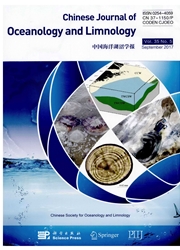

 中文摘要:
中文摘要:
Dissolved fluorescent organic matter was measured using fluorescence excitation-emission matrix spectroscopy at three temporal points during a Synechococcus bloom after diatom bloom dispersion in spring, 2007. Carbohydrate and dissolved organic carbon were also analyzed. The relationship between organic matter and red tide succession was examined. The results show that after the diatom bloom, tyrosine-like fluorescence B intensity was very high within the water column and exhibited a negative correlation with chlorophyll a over the period of the Synechococcus bloom. Other organic matter did not exhibit this relationship with chlorophyll a. This implied that diatom bloom dispersion resulted in the release of large quantities of tyrosine-like compounds into the water. These may play a role as a nutrient source or growth-stimulating substance for the subsequent Synechococcus bloom.
 英文摘要:
英文摘要:
Dissolved fluorescent organic matter was measured using fluorescence excitation-emission matrix spectroscopy at three temporal points during a Synechococcus bloom after diatom bloom dispersion in spring, 2007. Carbohydrate and dissolved organic carbon were also analyzed. The relationship between organic matter and red tide succession was examined. The results show that after the diatom bloom, tyrosine-like fluorescence B intensity was very high within the water column and exhibited a negative correlation with chlorophyll a over the period of the Synechococcus bloom. Other organic matter did not exhibit this relationship with chlorophyll a. This implied that diatom bloom dispersion resulted in the release of large quantities of tyrosine-like compounds into the water. These may play a role as a nutrient source or growth-stimulating substance for the subsequent Synechococcus bloom.
 同期刊论文项目
同期刊论文项目
 同项目期刊论文
同项目期刊论文
 期刊信息
期刊信息
